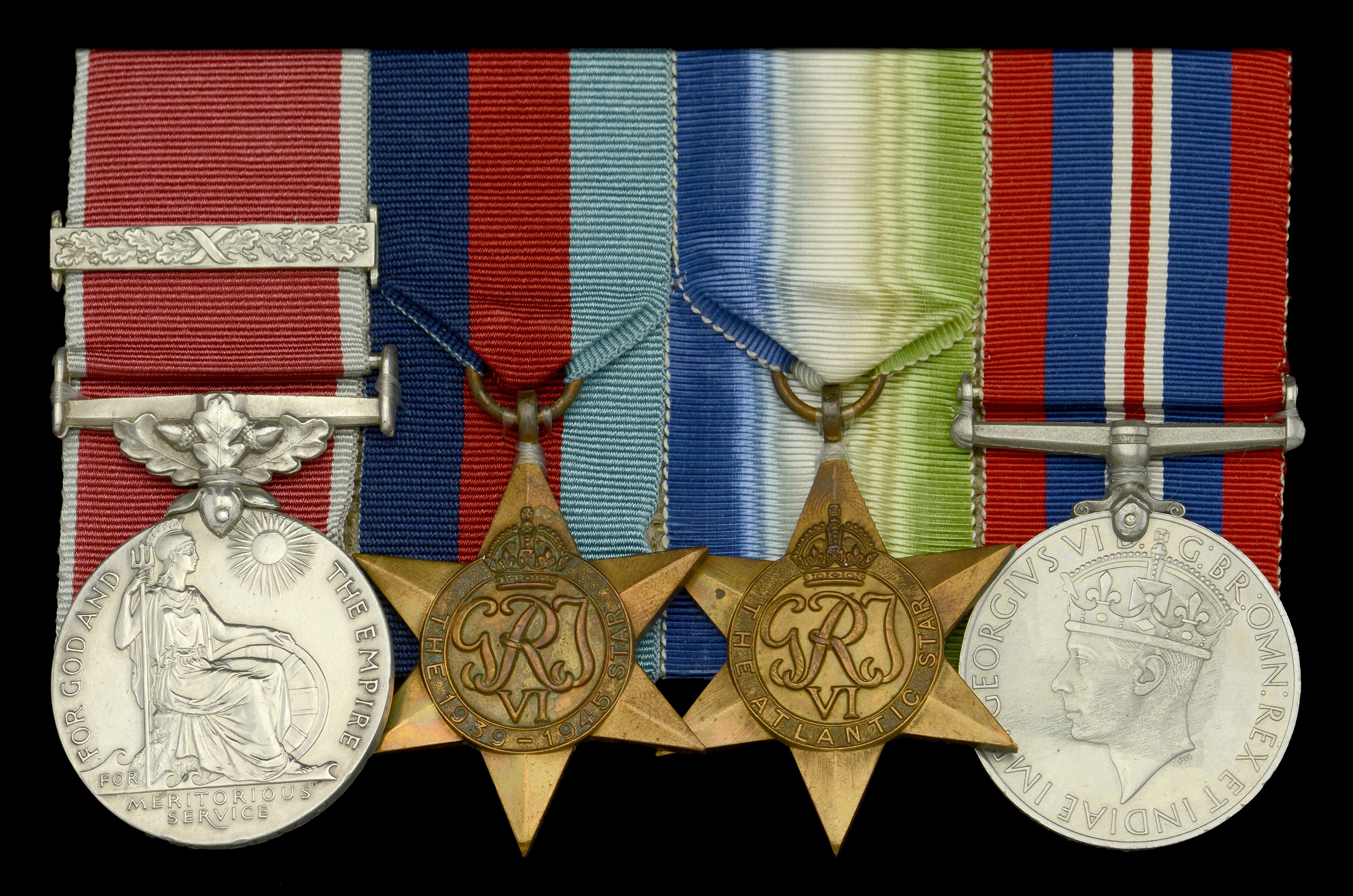The extremely rare Second War B.E.M. and Bar group of four awarded to Fireman and Greaser A. Letch, Merchant Navy; originally decorated for his gallantry during an enemy aircraft attack off the Humber in February 1942, he added a Bar to his award for top-secret, blockade running Operation ‘Bridford’, a risky enterprise undertaken in a modified Motor Gun Boat to collect valuable steel and ball bearings from Sweden British Empire Medal (Civil), G.VI.R., 1st issue (Albert Letch) with Second Award Bar; 1939-45 Star; Atlantic Star; War Medal 1939-45, mounted as worn, good very fine (4) £2,000-£3,000 --- Importation Duty This lot is subject to importation duty of 5% on the hammer price unless exported outside the UK --- --- Provenance: J. Hoare Auctions, Canada, April 2000. Abbott & Tamplin state in British Gallantry Awards that just 12 Bars were awarded to the British Empire Medal in the Second World War. B.E.M. London Gazette 12 May 1942: ‘The ship was attacked by an aircraft with bombs and machine-guns. The Master’s defence organisation was very efficient. Under his orders the First Mate and Second Officer held their fire until the range was close and then shot so accurately that the aircraft crashed into the sea. She had dropped bombs which exploded close to the ship’s stem. Excellent work was done by the Second Engineer, who was on watch. He remained at his post and calmly carried out with distinction urgent measures to secure the safety of the ship. Fireman Letch stuck to his post in the stokehold and carried out his duties during and after the action in a cool, calm and collected manner, even though the stokehold plates were thrown about by the explosions. It was due to the general resourcefulness of the ship’s company that the vessel reached port under her own power.’ Bar to B.E.M. London Gazette 2 May 1944: ‘For gallantry in hazardous circumstances.’ Albert Letch was born in Grimsby, Lincolnshire on 18 November 1921. Awarded the B.E.M. for his gallantry as a Fireman aboard the S.S. Helder, when she was bombed and strafed in the Humber on 5 February 1942, official records also reveal that he afterwards served in the Royal Mail’s steamship Highland Brigade; he was likewise employed when she was diverted to New York following a storm off Bermuda in March 1943. Letch subsequently volunteered for Operation ‘Bridford’, part of an ongoing top-secret programme devised by Commander Sir George Binney, D.S.O., R.N.V.R., to ferry supplies of ball bearings and special steels, as well as occasional ‘passengers’, from Sweden to the U.K. The story of ‘Bridford’ and its predecessor operations is recounted in On Hazardous Service, by A. Cecil Hampshire, and a fascinating story it makes, for as Binney himself concluded: ‘Each trip in the running of this closely guarded Axis blockade has, of course, involved the dangerous sea passage through the Skagerrak and Kattegat between the enemy-occupied countries of Norway and Denmark … The operations owed their success to a combination of careful planning, courage, bluff and grand seamanship and sometimes perhaps there was an element of good luck.’ Binney managed to get hold of five Motor Gun Boats (M.G.Bs) for Operation ‘Bridford’. The boats, built by Camper and Nicholson, were 117-feet long and had three diesel engines which could produce a cruising speed of about 20 knots. After some modification, they could take a 45-ton cargo, and they were armed with Oerlikon and Vickers machine-guns. Manned by Merchant Navy volunteers, such as Letch – and hence flying the Red Ensign, each boat also had an S.O.E.-appointed Chief Officer to oversee the security and defensive arrangements. Binney named his five modified boats Gay Corsair, Gay Viking, Hopewell, Master Standfast and Nonsuch, thereby adding to the Elizabethan atmosphere of the adventure on which they were engaged. And to add a final touch to that sense of adventure, he ensured that ‘in each Captain’s cabin there was a picture of Sir Francis Drake.’ As it transpired, Master Standfast was captured by the Germans on her very first mission in November 1943, but the remainder of Binney’s flotilla plied back and forth from Hull and Immingham to the small Swedish port of Lysekil until March 1944. For his own part Letch served as a greaser in (ex-M.G.B. 505) Nonsuch, under ‘the tall, slim and quiet-mannered’ Captain Herbert ‘Jacko’ Jackson. And the boat’s S.O.E.-appointed Chief Officer was Ted Ruffman, who, according to On Hazardous Service, ‘was an ex-Artillery lieutenant who had been invalided from the army after having had most of his face shot off at Tobruk.’ Letch may have served in other ships of the secretive flotilla, but we know for certain from official records that he joined Nonsuch for a run over to Sweden in February 1944, when ‘the boss’, George Binney, came along for the ride. Happily, it would seem, Nonsuch dodged the mines and German patrol boats, and returned to Immingham with a 40-ton cargo valued at 570,000 Swedish Kroner. He was among those subsequently selected for reward, in his case an extremely rare Bar to his B.E.M. Whether he remained in Nonsuch for her future role in S.O.E.’s Operation ‘Moonshine’ remains unknown. He died in Grimsby in November 1990. Sold with copied research.





